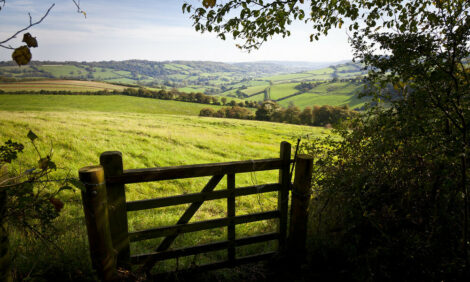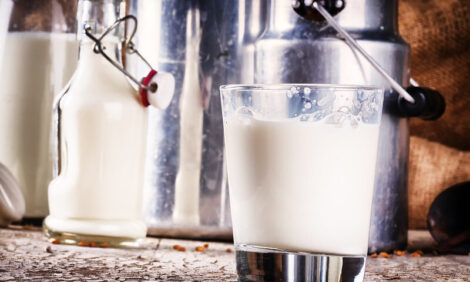



Feeding Cows This Winter
Our year in Virginia began under plenty of snow which gave way to a muddy March and more recently into a dry summer and early fall, says Dr Mark Mc Cann, Extension Animal Scientist from Virginia Tech.|
Beef Management Tips |
Growing and storing adequate forage for the upcoming winter has been challenging in most localities and in some areas grazeable forage has been short during a few times during the summer drought. Now cattle producers are faced with an ever shrinking growing season, diminished forage reserves and the unknown winter ahead. As we try to squeeze this pile of lemons, rest assured that we have some time tested strategies that can be utilized to manage our limited feed resources.
- Wean calves. Most spring born calves are programmed to be weaned in the near future. Weaning calves will allow the dry cow to get by on a minimum of forage quality and quantity. Better forage (if available) and supplement can be provided to calves at a higher level and more efficiently than milk from a cow in late lactation on drought stressed pasture. Consider taking advantage of preconditioning your calves and identifying them as such at marketing.
- Strategically cull. The goal is to carry forward and winter only bred females. Depending on your local conditions and the stocking change you need to make, additional selection pressure can be put on potential function problems such as eyes, poor feet and legs and poor temperament. Done correctly, stocking rate is reduced, cash is generated to potentially purchase feed if needed and the resulting herd is more efficient and has a greater potential for future profit.
- Critically assess forage inventory, quality and condition. Forage harvest is mostly over, so a factual inventory is needed to form a basis for winter feed decisions. Realize that last year’s long, snowy winter is probably not the best foundation to predict hay needs. Make sure that inventory includes carryover hay.
Typically, it takes two bales of hay carried over outside to equal one bale of this year’s crop due to spoilage. Hay carried over in the dry will not change significantly in energy or protein content. Vitamin content of carried over hay (stored inside or outside) should be assumed to be nil.
Cattle fed carried over hay should receive supplemental vitamins via their mineral or supplement. Also be aware that sheltering this year’s hay harvest is important. In a time of forage shortage, you cannot afford to lose 20 per cent to weather loss. Tarps, barns and sheds will work and extend the limited amount of hay on hand.
- Shop for hay. Based on inventory and condition of your forage supply, now is the time to look at choices and options. Hay is limited but not impossible to locate. Some areas in-state and in neighboring states have had a productive year and hay is available.
Freight can be as great a cost as the hay itself so shop local if possible. VDACS has a hay clearing house posted on-line at http://www.vdacs.virginia.gov/marketnews/pdffiles/hay.pdf and a listing for out-of state sources at http://www.vdacs.virginia.gov/marketnews/haylinks.shtml. The Virginia Cattlemen’s Association has also initiated a hay clearinghouse on their website http://www.vacattlemen.org/. If you are aware of someone with hay, encourage them to list it on the clearinghouse or advertise it locally.
- Explore forage alternatives. As we move into other crop harvests; corn stalks, soybean stubble, peanut vines and cotton gin trash can all serve as roughage sources for cattle. In some situations fields can be grazed and in others these crop aftermaths can be packaged and shipped. Round bales of the crop aftermath will not shed rain like grass hay and should be stored in the dry. In some situations, vegetable crop culls are a potential alternative feed. Recycled poultry bedding can be an option if you are in or near a supply.
A pound of corn can supply the energy of almost two pounds of hay. As you compare alternatives don’t rule out grain or feed by-products as a substitute for hay. At first glance it might appear too costly, but compare it on a lb of TDN basis before you reach a conclusion. Meeting halfway might be the smartest approach; limiting feeding hay and feeding some supplement.
- Forage test. Regardless of your forage source, it is important to test your feedstuffs to allow matching forage quality to cattle nutrient needs. Most of the crop aftermath and other waste materials have lower protein and energy content and are a better match for the nutrient needs of dry cows rather than lactating cow or stockers. It is particularly important to be informed on dry matter content of high moisture feeds that you may consider. Knowing the DM content will allow a more accurate price comparison and insure that you do not underfeed dry matter. Also be aware high moisture products can be perishable items if not ensiled or fed quickly. This can be especially true of vegetable or fruit waste.
- Manage what you have. Most cattlemen have been stretching pasture resources by grazing extra areas and boundaries, as well as rotating pastures. If and when we receive rain, keeping cattle confined to a smaller area and allowing stressed pastures a chance to rebound will produce more total forage growth than allowing cattle free access to a whole boundary and allowing them to graze off the tender regrowth. Feeding some carry over hay would be a better use of resources. Depending on October moisture and temperatures we can still grow a significant amount of forage if we allow forages a chance.
- Fall calving cows. Much of the above is targeting spring calving cows. Cows calving this fall have few options other than meeting the cow’s nutrient needs as cheaply as possible until the cow is bred back. Post-breeding there are other options such as early weaning or reducing nutrition and letting the cows rough it. That is too far away to reach any conclusions. First of December will be a better time to start considering those options.
- Monitor cow body condition. Regardless of calving season, keep a close eye on cow body condition to monitor the impact of your nutrition program during this fall period.
The old saying is “Every drought is followed by a good rain”. I hope you have experienced that feeling before you read this. Either way, the points above can stretch your resources and perhaps assist you in making lemonade from the lemons we have been dealt.



